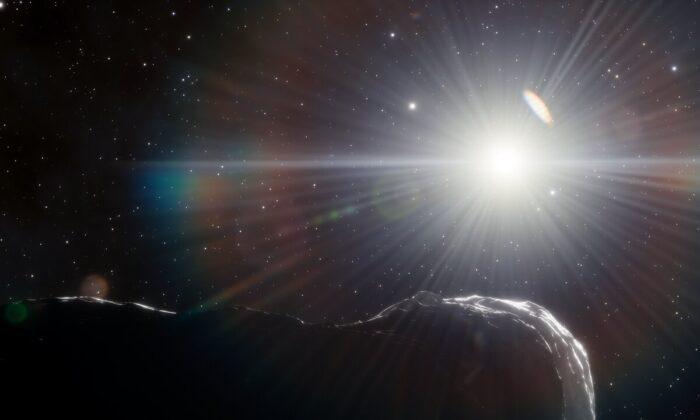Astronomers have discovered three asteroids hiding in the sun’s glare, one of which could potentially collide with Earth in the future.
Astronomers were able to spot the three near-Earth asteroids (NEAs) hiding in the glare of the Sun through twilight observations with the U.S. Department of Energy’s Dark Energy Camera at Cerro Tololo Inter-American Observatory in Chile.
They discovered the three NEAs hidden in the inner solar system, the region interior to the orbits of Earth and Venus.
One of the NEAs is a 1.5 kilometer-wide (0.9 miles) asteroid called 2022 AP7, which researchers say is “likely the largest Potentially Hazardous Asteroid (PHA)” to be discovered in the last eight years and has an orbit that could someday see it collide with Earth.
“Based on its brightness and the way it reflects light, 2022 AP7 is probably between 1.011 to 2.260 kilometers in diameter, making it larger than 99 percent of asteroids, very roughly comparable in size to the U.S. Pentagon,” Space Reference states.
However, when exactly 2022 AP7 might collide with the Earth is difficult for scientists to predict.
‘Planet Killers’
“Our twilight survey is scouring the area within the orbits of Earth and Venus for asteroids,” said Scott S. Sheppard, an astronomer at the Earth and Planets Laboratory of the Carnegie Institution for Science and the lead author of the paper describing this work, in a press release by SpaceRef. “So far we have found two large near-Earth asteroids that are about 1 kilometer across, a size that we call planet killers.”Finding asteroids in the inner Solar System is a challenging task for astronomers, who have just a brief 10-minute window to do so every night while contending with the brightness of the sun, which shields them from telescope observations.
Additionally, their telescopes must focus very close to the horizon, meaning that they have to look through a thick layer of Earth’s atmosphere, which can in turn blur and distort their observations
“There are likely only a few NEAs with similar sizes left to find, and these large undiscovered asteroids likely have orbits that keep them interior to the orbits of Earth and Venus most of the time,” Sheppard added. “Only about 25 asteroids with orbits completely within Earth’s orbit have been discovered to date because of the difficulty of observing near the glare of the Sun.”
“It would be a mass extinction event like hasn’t been seen on Earth in millions of years,” he said.





